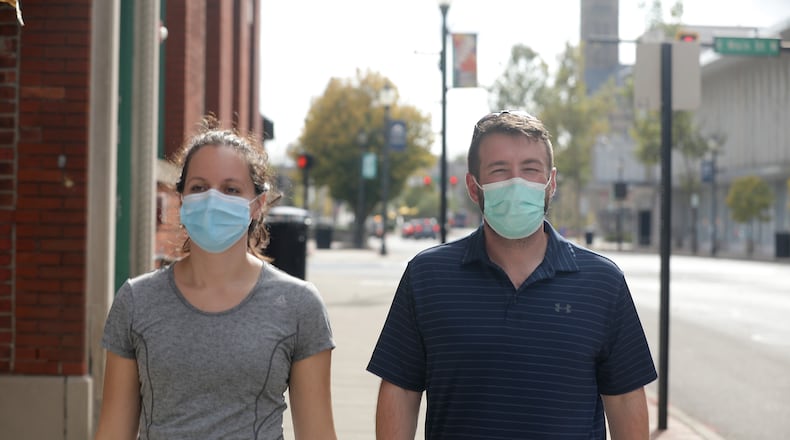“If you want to see your family, please wear masks and socially distance yourselves,” Trout added.
Clark County officials are also seeking more testing and hoping to distribute more masks.
Last week, Clark County was one of three counties placed on the watch list for purple, or level 4 on the Ohio Public Health Advisory System. If the county’s status doesn’t improve, it could move to purple on Thursday.
“Most of the spread is coming from small, informal gatherings, where people are with friends and feel safe,” Trout said. “Unfortunately, the virus does not care who you are near, it will spread.”
The other two counties placed on the watch list are Hamilton and Cuyahoga.
The state’s advisory system, which monitors the spread of the coronavirus, ranges from level 1 or yellow as lowest to level 4 or purple as highest and most severe.
Purple means there is" severe exposure and spread" of COVID-19. No county has reached the highest level on the color-coded scale since the state launched the advisory system in early July,
The Ohio Department of Health (ODH) uses seven indicators when judging what level to give a county. Clark County hit six of those indicators last week, the most the county has ever hit in a single week.
Indicators hit include new cases per capita, sustained increase in new cases, proportion of cases not in a congregate spread, sustained increase in emergency department visits for COVID-like illness, sustained increase in outpatient visits for COVID-like illness and sustained increase in new COVID hospital admissions. The only indicator the county did not hit is ICU bed occupancy.
Even though the county is on the watch list for level 4, the state does not impose further restrictions on counties based on the alert level. DeWine said the purple (level 4) guidance is to stay home except for necessary travel to get supplies and services.
According to CCCHD data, the city of Springfield has attributed to 51.7 percent of coronavirus cases, followed by Moorefield Twp. with 12 percent, Springfield Twp. with 8.7 percent, Bethel Twp. with 6.5 percent and New Carlisle with 4.6 percent.
Trout said the “sharp rise” in COVID-19 cases in the Northridge area is connected to the percentage of coronavirus cases in Moorefield Twp. Those cases are also connected to an outbreak in the Northeastern Local School District.
The health district is seeing an uptick in cases in New Carlisle and Medway and is focusing on planning a pop-up testing event in that area, Trout said.
If the county secures a pop-up testing site in the area, it would most likely be within three weeks, Trout said. He added that the cases in that area are “largely attributed to community spread.”
According to CCCHD data, 59 of Clark County’s 77 confirmed COVID-19 related deaths are long-term care residents.
Trout said that the 70 to 99 age range is accounting for 83 percent of the deaths the county is seeing, but that same age range is only accounting for 15 percent of the county’s COVID-19 cases.
“It is unsafe to say “the case increase is attributed to long-term cares” because then people may think, “oh, it’s safe for me to go out, not wear a mask, not social distance, etc.” Unfortunately, that mindset ends up increasing community spread, which means employees of long-term care facilities, through no fault of their own, get the virus and bring it into nursing homes where these high risk individuals are,” Trout said.
“Residents of these nursing homes are not leaving the nursing home and bringing COVID-19 back, uncontrollable community spread is allowing the virus to sneak in and unfortunately kill these high risk individuals,” he added.
In an attempt to slow the spread of the coronavirus, the county plans to continue distributing masks.
Over the weekend, the Clark County Commissioners in partnership with the city of Springfield, the county’s Emergency Management Agency (EMA) and the sheriff’s office distributed 2,000 masks in New Carlisle and Springfield.
Michael Cooper, Clark County’s public information officer, said they are hoping to distribute masks to the south side of Springfield by working with the Springfield Unit of the NAACP and at bus stops by working with the Clark County-Springfield Transportation Coordinating Committee.
In total, 40,000 masks have been distributed to local residents and agencies, Cooper said.
“We’re happy people came out to our event on Saturday and we appreciate them taking it seriously," Cooper said. "Especially at this time, it is important for everyone to have access to a mask and to wear it when they go out in public. We want to stop the spread (of COVID-19) as best as we possibly can.”
The CCCHD is in the process of finding a permanent site for people to get coronavirus testing.
Trout said they are looking at using the Occupational Health building, located at 2501 E High St., because it has room for expansion and for social distancing.
He added that this would be temporary and only some employees would move there.
Clark County had 2,631 cases, 77 deaths and four probable deaths of the coronavirus as of Monday afternoon, according to the Ohio Department of Health’s (ODH) website.
The state recorded 200,231 total cases and 5,217 total deaths attributed to the virus, according to ODH. On Saturday, the state broke its record for daily cases reported for the fourth day in a row with 2,858. In the last two weeks, the record has been broken seven times.
Clark County residents in need of a mask should call the CCCHD at 937-390-5600.
By the numbers
200,231: Total coronavirus cases in Ohio
5,217: Total coronavirus deaths in Ohio
2,631: Clark County confirmed coronavirus cases
77: Confirmed coronavirus deaths in Clark County
About the Author

